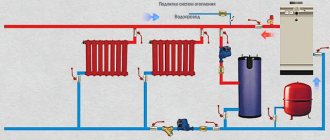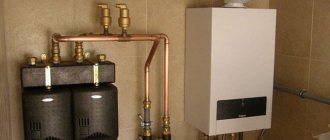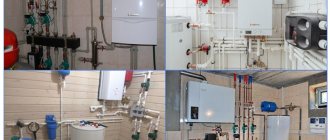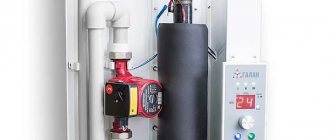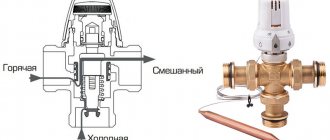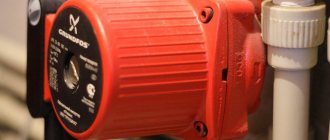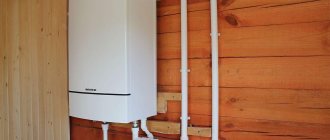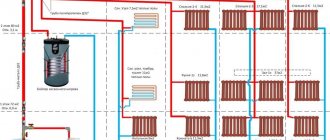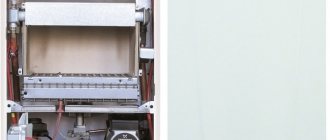Electric boiler EVAN EPO-4
The EPO-4 boiler is a stationary electric device with a power of 4 kW, designed for heating various residential and industrial premises with an area of up to 40 m2.
EPO-4 boilers are powered by single-phase three-wire alternating current sources with a voltage of 220 Volts and a frequency of 50 Hertz. Equipped with single-stage control panels. Specifications
| Characteristic | EPO-4 |
| power, kWt | 4 |
| Operating voltage, V, ±10% | 220 |
| Heated area (m2), with a ceiling height of 2.7 m | 40 |
| Stage power, kW | 4 |
| Overall dimensions of the boiler (mm) / pipe thread G | 565x270x220 / G 1¼ |
| Overall dimensions of the remote control (WxHxD) (mm) | 135x250x115 |
| Boiler/control panel weight, kg | 15 / 1,5 |
| Cross-section of the supply cable core, mm2 | 4 |
| Working pressure in the boiler, no more | 0.3 MPa |
| Boiler test pressure | 0.5 MPa |
| Pressure testing of the heating system with boiler after installation, no more | 0.4 MPa |
| Coolant temperature adjustment range | 30-85 °C |
| Self-resetting alarm temperature | 92±3 °С |
| Boiler efficiency EVAN EPO-4 | 93% |
| Warranty period | 18 months |
Advantages of EVAN EPO-4 boilers
- Profitability due to low investment cost and rational use of electricity, which is achieved through the use of an automatic room temperature control system in the electric boiler.
- Easy installation and maintenance.
- No additional costs - no investment required during operation.
- Compact - no separate room required.
- Versatility - can be used as a main or backup heat source.
- Environmentally friendly - does not reduce the level of oxygen in the room, there are no harmful emissions of combustion products.
- Reliability in energy supply - electricity is the least dependent on the availability of traditional raw energy sources (oil, fuel oil, gas, coal, etc.).
- Independence from external factors - the temperature in the house does not depend on the operation of thermal power plants and utilities, there is no seasonal drop in gas pressure in the gas pipeline, it maintains the set temperature in the room regardless of weather conditions.
Structure and dimensional drawing
1 - housing, 2 - heating element, 3 - protective casing, 4 - emergency thermal switch with self-reset, 5 - thermostat sensor, 6 - inlet pipe, 7 - outlet pipe, 8 - M8 clamp for the neutral protective conductor PE9 - coverInstallation and installation instructions
Before installing the boiler, check the correctness and quality of installation of the natural circulation heating system. The heating system pipes must be located so as to promote natural coolant circulation. In this case, the maximum coolant level should not exceed 30 meters to the boiler level (working pressure in the boiler is not higher than 0.3 MPa). If it is impossible or undesirable to achieve natural circulation of the coolant in the heating system, it is necessary to use a circulation pump. The heating system must have an expansion tank communicating with the atmosphere. When using a membrane-type expansion tank, a safety valve rated for a pressure of no more than 0.4 MPa must be installed at the boiler outlet in front of the ball valve. Since when the safety valve is activated, coolant or steam may be released through its drain hole, it is necessary to drain this hole into the sewer system. Ball valves are installed at the inlet and outlet of the boiler, which are used during dismantling, repair and maintenance of the device. Installation of shut-off valves on the pipeline connecting the expansion tank to the heating system is prohibited!
Pressure testing of the heating system with the boiler after installation is no more than 0.4 MPa.
The boiler must be installed in a vertical position (protective casing at the top). The control panel is mounted vertically at a height of 1.4-1.7 m from the floor on walls and structures in well-lit rooms.
Connection diagram of the boiler to the heating system Order electric boilers EPO-4
Principles for choosing an electric boiler
When purchasing a boiler, there are several other factors to consider.
A very important parameter is the boiler power. For modern OK it varies from 2.5 kW to 60 kW. A weak boiler will not cope with providing heat to the room; an overly powerful one will lead to unreasonable expenditure of electricity and money. The required power is calculated using a special formula. To find out the power, you will need to multiply the area of the room by the specific power (DP). The second indicator is set separately for each region. The figure obtained as a result of multiplication must be divided by 10. Let's say the house is located in the Moscow region, where the UD is 1.2 kW. The area of the house is 200 square meters.
Power adjustment deserves attention when choosing. It comes in two types:
- stepped;
- smooth.
The first type of regulation is used in devices with independent electric heaters. As a rule, with this adjustment option, the boiler can be operated at 25, 50, 75 and 100 percent of the designed power.
For smooth regulation, a rheostat is required.
In cheap units whose power is low, there is no possibility of regulation.
When purchasing an OK, rated for 380 volts, it is necessary to be able to connect a three-phase power line to the house.
You should look at how many circuits the OK is designed for. Electric boilers are usually not used to heat two circuits because they consume too much electricity.
Automation OK is important. It ensures the safety of the unit and allows you to rationally use electricity by regulating the temperature
It is practiced to install two types of thermostats:
- mechanical;
- electronic.
A mechanical type thermostat operates either on bellows filled with gas or liquid, or on bimetallic plates. When the temperature reaches the set value, the thermostat opens the electrical circuit. After the temperature drops below a certain level, the thermostat turns OK again. Mechanical automation is simple, resistant to voltage surges, but not sensitive enough. Deviations from the set temperature by two to three degrees are possible.
Electronic automation can control both the temperature of the room and the coolant. It is characterized by high sensitivity and accuracy in operation. The temperature can be changed using the control panel or by preset programs. The cost of such automation is higher than mechanical.
OK are sold in a basic configuration and with additional options (expansion tank, remote thermostat, etc.) They may or may not be needed. Before abandoning the purchase of additional devices, you should calculate the results of such a step. If you need to purchase them after purchasing the basic version of the electric boiler, it will cost more.
OK housings can be made of various materials (steel, copper, plastic, etc.). The material affects the strength of the body and fire safety.
The price of the unit is influenced by several factors:
- power;
- number of circuits;
- additional options;
- type OK;
- manufacturer.
For example, electric boilers from well-known European brands will, of course, cost more than Chinese or Russian ones. Heating element OKs cost less than electrode or induction ones.
Russian electric boiler "Zota"
Delivery terms
The delivery driver can provide loader services only by prior arrangement for an additional fee.
Upon delivery to the Buyer, the seller is responsible for the appearance of the goods until the moment of acceptance and transfer to the Buyer. Claims regarding the appearance and configuration of the delivered goods, in accordance with Art. 458 and 459 of the Civil Code of the Russian Federation, can only be presented before the goods are transferred by the Seller to the Buyer. From the moment of acceptance and delivery of the goods, the seller’s obligation to transfer the goods is considered fulfilled. The fact of acceptance of the goods by the Buyer is confirmed by a signature in the “Purchase and Sale Agreement” in the column “Acceptance and Transfer Certificate”. If the appearance or configuration of the goods does not correspond to the proper quality, the buyer has the right not to accept the goods and not to sign the documents.
Features of choice
After deciding to purchase an electric boiler, you need to understand the types and technical parameters that distinguish different models.
Technical characteristics of electric heating boilers EVP Stanless
Types of boilers
Electric boilers are:
- Heating elements.
- Induction.
- Electrode.
Heating element boilers are the most common. They work the same way as a kettle. Heat is transferred to the room by driving water through pipes, heated by boiler heating elements. Different boiler models can have from 1 to 3 heating elements. The power indicated for an electric boiler is the total power of all its heating elements. The water in the pipes is driven by a circulation pump.
The models have been on the market for a long time - the work has been streamlined, the design has been thought out.
Heating element heating boiler - diagram
Induction boiler. It has a dielectric tube wrapped with wire, inside which there is a core closed to itself (made of any metal to which a magnet can stick). The current passing through the coil creates an electromagnetic field and causes the molecules in the core to move, heating it.
An induction boiler is a very reliable device. The only thing that can break in it is the electronic control unit. The price of induction boilers is higher than others. But the sellers’ assurances about innovative technologies and great efficiency are based on nothing and contradict the laws of physics. Induction principles were discovered by M. Faraday almost 2 centuries ago and have long been successfully used in industry.
Induction electric boiler
Electrode boilers heat by passing current through the water. The problem is that you can only use water that can be called “drinking” according to GOST.
The electrodes in such boilers dissolve over time and require replacement.
Heating element boilers should not be connected to a running water supply - scale forms on the heating elements, which is more difficult to deal with than in a kettle. Therefore, it is better to use the same coolant in the system. Also take a closer look at models that have filters.
Power
The power of the unit will depend on the dimensions of the room to be heated.
An important role will be played by the quality of insulation and thermal conductivity of the building materials used in the construction of the house.
Approximate calculation for a reliably insulated house with a ceiling height of about 3 meters:
For 10 m2 of area, 1 kW of electricity is required.
If the house is located in areas with harsh winters, you need to add 10% to the resulting power indicators.
Choose units in which the power can be adjusted taking into account the weather (the thermostat can be built-in or connected separately). Then the theoretical costs of electricity will actually be much lower.
Voltage and cable
In both cases, you need to connect through a separate machine on the meter, which will protect the network.
Before buying powerful boilers, evaluate the real capabilities of your electrical networks.
The cross-section of the cable should be larger, the higher the load on it and the more devices will operate simultaneously in the house.
For example, a 4mm2 copper wire at a voltage of 220 v can power an 8 kW boiler, and at a voltage of 380 v – a power of 19 kW. A copper wire with a cross section of 6 mm2 at a voltage of 220 v will pull 10 kW of power, and at a voltage of 380 v - 26 kW.
Manufacturer
The most affordable boilers, which have proven themselves to work well, are from domestic companies - RusNit, Nevsky, Evan.
German units (Bosch) will cost the most. They are crammed with automation and are famous for their reliability.
Wall-mounted heating boiler Evan
Other popular manufacturers:
- Eleko, Elbeva, Protherm (Slovakia) - adapted to the Russian climate;
- Dacon (Czech Republic) - about 30 boilers with a capacity from 4 to 60 kW;
- Kospel (Poland).
Connecting an electrode boiler
We will not describe in detail each stage of work. How to connect radiators, connect metal-plastic pipes. You can watch all these steps in the video instructions. The Galan electrode boiler connection technology is considered quite popular today.
As you can see, the installation is considered quite simple. Anyone can do it with their own hands. Now we will tell you about what rules you need to take into account when installing an electrode boiler with your own hands. An electrode boiler uses a lot of electricity, so it's best to look into cheaper heating options. To ensure your system is reliable, you need to consider the following recommendations:
Before connecting the electrode boiler, you need to configure the coolant. The Galan company recommends using a special liquid “Argus-Galan”. This fluid must be changed every 5 years. You also need to remember that it is strictly forbidden to use “Arctic” and “Antifreeze” liquids.
- The old heating system must be flushed to remove salt deposits. Dirty radiators can negatively affect the density of the coolant. To flush your energy carriers, it is recommended to use a special inhibitor “Protector”.
- The electrode boiler cannot be connected without grounding. We recommend using copper wire as a conductor. The ground wire must be connected to the terminal marked “0”.
- The coolant consumption should be 8 liters per 1 kW of power. Thanks to this, you can reduce energy costs.
- A deaerator valve must be installed at the highest point of the system. Also, connecting an electrode boiler cannot be done without installing a pressure gauge.
Shut-off valves must be installed behind the expansion tank.
- The heater body must be installed in a vertical position. Any imbalance can negatively affect the operation of the system.
- When choosing a radiator, the product must be installed from bimetal. These metals have fewer impurities and do not affect the electrode boiler.
- When installing an electrode boiler with your own hands, you cannot use cast iron batteries. These products can get dirty quickly and therefore use a lot of heat.
- If necessary, several heaters can be installed in series. It is fashionable to use a group of boilers in a two-story house.
Now you have learned how to connect an electrode boiler in a house or apartment yourself. As you can see, connecting the electrode boiler does not take much time.
We recommend reading: installing an instantaneous water heater.
How to choose an electric boiler?
The difference between a single-circuit and a double-circuit boiler lies in such characteristics as power and the ability to act as a “flow-through” for a long time. Therefore, in order not to make a mistake when choosing an electric double-circuit heating boiler, you need to focus on the following parameters:
- it must be a model from a well-known manufacturer that has a wide network of dealer and service centers;
- the power must be sufficient for the device to be able to solve the assigned tasks. Moreover, it must be equipped with at least 3 heating elements. Before you go to the store, you should find out the heat loss in your home. It is best if this work is performed by a specialist or you can use special online calculators;
- the model should provide for a multi-level security system. When heating, the temperature should not rise above 90 C; in case of overheating, a protective mechanism should be activated, a dry run must be present, etc.;
- Even before purchasing a boiler, decide on additional equipment, which means a heat accumulator and stabilizer. With the help of these devices, you can practically eliminate defrosting of the heating system and avoid major repairs, which require considerable expenses.
Keep in mind that it is advisable to install floor-standing models in a special utility room, unlike wall-mounted devices, which have no restrictions in this regard.
Commissioning works include
Connecting the boiler to the electrical network;
Filling the system with coolant;
Removing air from the heating system;
Bringing the pressure to normal in accordance with the requirements of this operating manual (when using an expanzomat);
Trial run;
Adjustment of the system and shut-off valves;
Before installing the boiler, check the correctness and quality of installation of the heating system with natural circulation. The pipes of the heating system must be located so as to facilitate the natural circulation of the coolant. In this case, the maximum coolant level should not exceed 30 meters to the boiler level (working pressure in the boiler is not higher than 0.3 MPa). If it is impossible or undesirable to achieve natural circulation of the coolant in the heating system, it is necessary to use a circulation pump. The heating system must have an expansion tank communicating with the atmosphere. When using a membrane-type expansion tank, a safety valve must be installed at the outlet of the boiler in front of the ball valve, designed for a pressure of no more than 0.4 MPa. Since when the safety valve is activated, coolant or steam may be released through its drain hole, it is necessary to connect a drain to it sewer system. Ball valves are installed at the inlet and outlet of the boiler, which are used during dismantling, repair and maintenance of the device.
Installation of shut-off valves on the pipeline connecting the expansion tank to the heating system is prohibited!
The pressure testing of the heating system with the boiler after installation is no more than 0.4 MPa. The boiler must be mounted in a vertical position. The control panel is mounted vertically at a height of 1.4-1.7 m from the floor on walls and structures in well-lit rooms.
Advantages and disadvantages
Heating devices such as induction boilers, like other similar units, have their pros and cons. It is necessary to familiarize yourself in detail with both their positive and negative sides if you are going to install such equipment in your home. First, let’s look at what is good about induction types of heating boilers.
The main advantage of such units is their reliability. If such products have automation, then they can operate autonomously, and the owners do not have to constantly monitor them. In this case, only the absence of a thermal fluid can lead to a breakdown of the device - then the core body in the system can overheat too much and, as a result, melt.
Induction boilers are distinguished by high efficiency (over 90%). Of course, the specific value mainly depends on the design of the heat exchanger in the unit and other structural features of a particular model. The advantages of such units include the fact that their efficiency does not decrease over the years, so even after a long time you will not notice that your heating system has become less efficient.
Induction heating equipment is not subject to breakdowns - it will not require frequent and expensive repairs. To install such a unit, there is no need to additionally construct ventilation or a chimney, which often costs users a tidy sum.
Such equipment serves for quite a long time. If you use these types of heating boilers correctly, they can last more than 30 years, since there is nothing to burn in them, because the inductor is hermetically sealed in the housing and is reliably insulated from contact with the coolant. In addition, the coils are not twisted tightly and are filled with a special protective compound. For this reason, the possibility of damage to the turns is minimized.
The liquid in such systems is heated to high temperatures. The minimum value is 35 degrees Celsius. Such units are installed quite simply. Household models are a small piece of pipe, which is sealed on both sides. There are 2 fittings on the housing, which are necessary for connecting the coolant supply and return. There is also a cord to connect the automation. Connecting such systems is not particularly difficult - you can cope with this simple work without the involvement of specialists.
Induction heating systems are characterized by high operating efficiency. They are characterized by low inertia, so heating of the coolant begins very quickly (immediately after the system starts). Such boilers turn off just as quickly. In such a device, the waste coolant does not need to be changed too often. It is enough to do this once every 10 years.
These types of heating devices, as a rule, do not leak, since they do not have detachable internal connections. These units are capable of operating at both direct current and low voltage. According to experts, harmful scale does not accumulate on the heating element in such devices. This occurs due to the vibration of the core (because of this, excess particles cannot be deposited on it). In addition, scale will not accumulate due to the temperature of the coolant (not higher than 90 degrees Celsius) and the closed nature of the system, in which a limited number of carriers may be present.
Now it's time to get acquainted with their disadvantages:
- First of all, a number of disadvantages of such devices include their high price. They cost several times more than devices with heating elements. However, the high cost is due to the presence of automation.
- Usually these devices have an impressive weight. For example, a cauldron with a diameter of 12 cm and a height of 45 cm will weigh as much as 23 kg.
- These boilers are suitable exclusively for closed heating systems.
- Such units can create wave interference at a short distance. For this reason, experts advise installing them as far as possible from any household appliances.
- If you are going to install an induction boiler in a large house with 2-3 floors, then you will have to additionally install a high-power circulation pump - this is necessary for the device to operate stably.
- Induction units are energy dependent. If the electricity in your home is turned off, the heating will also stop working. Of course, this problem can be solved - you can purchase diesel generators, but this will be an additional expense.

